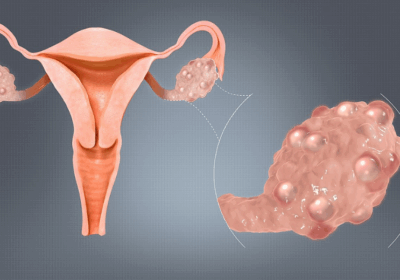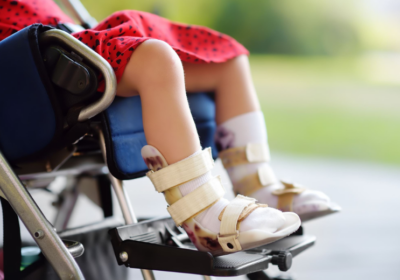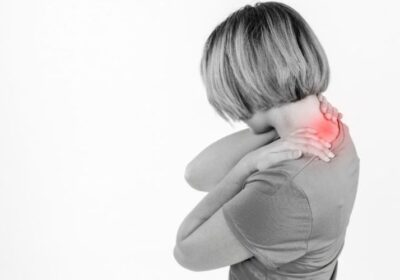AYURVEDA FOR SCIATICA: HOLISTIC HEALING APPROACH
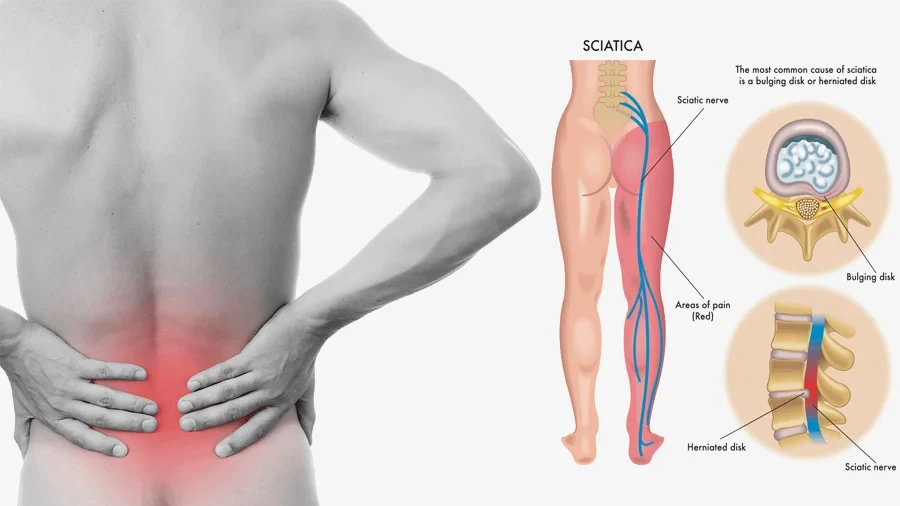
Sciatica is a painful condition caused by irritation or compression of the sciatic nerve, the largest nerve in the human body. This nerve runs from the lower back through the hips and down each leg.
When the nerve is compressed or inflamed, it can cause sharp pain, tingling, numbness, or weakness that radiates from the lower back to the legs.
Sciatica in Ayurveda
In Ayurveda, Sciatica is known as Gridhrasi.
The term “Gridhrasi” originates from the word “Gridhra” (vulture), reflecting the limping gait observed in patients due to severe pain and stiffness.
Ayurveda sees sciatica not just as nerve compression, but as a systemic imbalance of Vata Dosha affecting the nerves, muscles, bones, and joints of the lower body.
Causes of Sciatica according to Ayurveda
When Vata Dosha becomes aggravated, it leads to dryness, constriction, and impaired movement of nerve impulses. This results in pain and stiffness radiating from the lower back down to the legs.
Common causes of Vata imbalance leading to Gridhrasi:
-
Overexertion, excessive walking, or heavy lifting
-
Prolonged sitting or standing
-
Exposure to cold and dry weather
-
Consumption of dry, light, or cold foods
-
Irregular eating habits or skipping meals
-
Age-related degeneration of the spine and joints
-
Injuries or trauma to the lower back or hip region
Conditions that can cause Sciatica
Several spinal and non-spinal conditions can compress or irritate the sciatic nerve, leading to pain that radiates from the lower back to the legs. The most common include:
1. Herniated Disc
A herniated (slipped) disc occurs when the soft inner material of a spinal disc bulges or ruptures through its outer layer, pressing directly on the nerve root.
2. Degenerative Disc Disease
Age-related wear and tear causes the discs between vertebrae to lose flexibility and height, leading to narrowing of nerve passageways and irritation of the sciatic nerve.
3. Spinal Stenosis
Narrowing of the spinal canal due to bone overgrowth, arthritis, or thickened ligaments can compress the spinal cord or nerve roots, producing sciatica-like pain.
4. Foraminal Stenosis
This is the narrowing of the small openings (foramina) through which nerve roots exit the spine. Compression at these points can trigger sciatic pain and leg numbness.
5. Spondylolisthesis
In this condition, one vertebra slips forward over another, causing instability and nerve compression in the lower spine.
6. Osteoarthritis
Degenerative joint changes and bone spurs (osteophytes) associated with osteoarthritis can pinch the nerve roots connected to the sciatic nerve.
7. Injuries or Trauma
Accidents, falls, or sudden twisting movements can damage spinal structures or soft tissues, leading to inflammation or direct compression of the sciatic nerve.
8. Pregnancy
Hormonal changes, weight gain, and postural shifts during pregnancy can increase pressure on the lumbar spine and the sciatic nerve, leading to temporary sciatica.
9. Tumours, Cysts, or Other Growths
Abnormal growths within or near the spinal canal can compress nerve tissue, resulting in persistent sciatic pain or neurological symptoms.
10. Conus Medullaris Syndrome
Compression or injury to the conus medullaris — the lower end of the spinal cord — can cause pain, weakness, and bladder or bowel disturbances similar to sciatica.
11. Cauda Equina Syndrome
A rare but serious condition caused by severe compression of the nerve roots at the lower end of the spinal cord. It can lead to leg weakness, numbness in the groin (“saddle anaesthesia”), and loss of bladder or bowel control. This is a medical emergency requiring immediate attention.
Clinical Features of Sciatica Based on Affected Nerve Roots (L4, L5, S1)
Sciatica symptoms vary depending on which nerve root is compressed — most commonly L4, L5, or S1. Each root produces a distinct pattern of pain, sensory loss, muscle weakness, and reflex changes.
1. L4 Nerve Root Involvement
-
Pain: Radiates from the lower back to the front of the thigh, knee, and medial leg.
-
Sensory Changes: Numbness or tingling over the medial leg and ankle.
-
Motor Weakness: Weak quadriceps leading to difficulty in knee extension or stair climbing.
-
Reflex Change: Knee jerk (patellar reflex) reduced or absent.
-
Gait/Posture: Patient may show a forward or lateral list and struggle to rise from sitting.
2. L5 Nerve Root Involvement
-
Pain: Travels from the lower back and buttocks down the lateral thigh and leg to the top of the foot and great toe.
-
Sensory Changes: Numbness or tingling over the outer leg and dorsum of the foot.
-
Motor Weakness: Weak ankle and toe dorsiflexion (foot drop common).
-
Reflex Change: No distinct reflex loss; may reduce the medial hamstring reflex.
-
Gait/Posture: Heel walking is difficult; the patient may lean away from the painful side.
3. S1 Nerve Root Involvement
-
Pain: Extends from the lower back and buttocks to the posterior thigh, calf, and outer foot.
-
Sensory Changes: Numbness or tingling on the lateral foot, heel, and sole.
-
Motor Weakness: Weak plantar flexion, leading to difficulty walking on toes.
-
Reflex Change: Ankle jerk (Achilles reflex) reduced or absent.
-
Gait/Posture: Toe walking is impaired, and the stance phase is shortened due to pain.
Diagnosis of Sciatica
Diagnosis of sciatica is based on a combination of clinical examination, neurological assessment, and imaging studies to identify the affected nerve root and the underlying cause of compression.
1. Physical Examination
(a) Inspection
-
Postural deformity: Patient may stand with a lateral list (trunk tilted to one side).
-
Lumbar lordosis: Often flattened due to muscle spasm or protective posture.
(b) Palpation
-
Localised tenderness over the lumbosacral spine or paraspinal muscles.
-
Muscle spasm and rigidity may be felt over the affected area.
(c) Range of Motion
-
Restricted lumbar movement, especially forward flexion.
-
Movements such as coughing, sneezing, or bending may aggravate pain.
(d) Neurological Examination
-
Evaluate motor strength, sensory loss, and reflexes corresponding to L4–S1 nerve roots.
-
Findings help localise the level of nerve root involvement.
(e) Special Tests
1. Straight Leg Raise (SLR) Test
-
Patient lies supine; examiner raises the leg with the knee extended.
-
Pain radiating below the knee between 30°–70° indicates L5 or S1 root irritation.
-
Crossed SLR (Well Leg Raise Test): Pain reproduced in the affected leg when the opposite leg is raised → highly suggestive of lumbar disc herniation.
2. Lasegue’s Test
-
Pain is reproduced when the foot is dorsiflexed while the leg is raised during SLR.
-
Indicates nerve root tension or irritation.
3. Femoral Nerve Stretch Test
-
Performed in the prone position; the hip is extended and the knee flexed.
-
Pain in the anterior thigh suggests L2–L4 root involvement.
4. Slump Test
-
Patient sits with hands behind back, flexes the spine and neck, and dorsiflexes the ankle.
-
Reproduction of radiating pain indicates neural tension or root irritation.
2. Investigations
(a) Imaging
• MRI Lumbar Spine — Gold Standard
-
Reveals disc herniation, nerve root compression, spinal stenosis, tumours, or infection.
-
Essential for confirming diagnosis before invasive treatment.
• CT Scan
-
Alternatively, when MRI is contraindicated (e.g., pacemaker).
-
Superior for assessing bony abnormalities.
• X-ray Lumbosacral Spine
-
May show disc space narrowing, osteophyte formation, or spondylolisthesis, but not nerve involvement.
(b) Electrodiagnostic Studies
-
Nerve Conduction Studies (NCS) and Electromyography (EMG) confirm radiculopathy and help exclude peripheral neuropathy.
(c) Blood Tests
-
ESR, CRP: To rule out infection or inflammatory causes.
-
CBC, blood glucose: To assess for systemic or diabetic neuropathy.
3. Differential Diagnosis
Piriformis Syndrome: Buttock pain radiating down the leg; negative SLR; tenderness over the piriformis muscle.
Facet Joint Arthropathy: Localised low back pain, not following dermatomal distribution.
Sacroiliitis: Pain near the sacroiliac joint, positive FABER test.
Peripheral Neuropathy: Bilateral, glove-and-stocking sensory loss, not radicular.
Hip Joint Pathology: Pain localised to groin/anterior thigh, not extending below the knee.
Treatment of Sciatica at Maurya Ayurveda
The sciatica treatment at Maurya Ayurveda blends the healing power of Ayurveda, Physiotherapy and Acupuncture.
AYURVEDA TREATMENT FOR SCIATICA:
1. Podi Kizhi(Choorna Pinda Swedam):
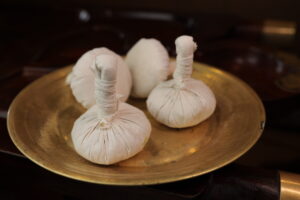
Podi Kizhi is a traditional ayurvedic Sudation therapy(swedana) involving the application of heated herbal powders tied in a cloth pouch(Kizhi) to the body. Kolakulathadi Choornam(medicinal powder) is normally used in our hospital for preparing Kizhi. It is usually done in about 30-45 minutes.
Benefits of Podi kizhi:
- It improves peripheral circulation.
- It helps in nerve rejuvenation.
- It aids in pain relief.
- It reduces numbness and tingling.
- It relieves muscle spasms and weakness.
- It reduces swelling and inflammation.
2. Dhara
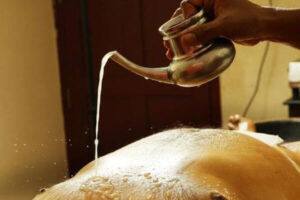
Dhara is a traditional Ayurvedic therapeutic procedure in which a steady stream of warm medicated liquid — such as herbal decoction, fermented liquid, milk, buttermilk, or medicated oil — is poured continuously over a specific part of the body or the whole body from a particular height.
Dhara therapy is highly effective in the management of Sciatica (Gridhrasi), as it helps to balance Vata dosha, reduce inflammation, and relieve radiating pain along the sciatic nerve. Among the different types, Dhanyamla Dhara and Kashaya Dhara are most beneficial for sciatica patients.
Dhanyamla Dhara
Dhanyamla Dhara is a specialised Ayurvedic therapy where a warm, fermented herbal liquid known as Dhanyamla is poured in a continuous stream over the lower back and affected limb.
This therapy is particularly useful in Vata–Kapha predominant conditions like Sciatica, where there is stiffness, inflammation, and nerve compression.
Procedure:
-
The warm Dhanyamla is poured rhythmically over the affected area for 30–45 minutes.
-
The gentle flow and warmth help loosen tight muscles and improve blood circulation.
Benefits:
-
Reduces nerve inflammation and radiating pain
-
Relieves stiffness and muscle spasm
-
Improves blood circulation and tissue nutrition
-
Detoxifies and rejuvenates the lower back region
Kashaya Dhara
Kashaya Dhara involves pouring warm medicated herbal decoctions (Kashayas) continuously over the affected region, especially the lower back and legs. The most commonly used decoction is Dashamoola Kashaya, known for its powerful anti-inflammatory and analgesic effects.
This therapy is ideal when Vata and Pitta doshas are aggravated — causing burning sensation, nerve irritation, and sharp, radiating pain.
Procedure:
-
Warm herbal decoction is poured rhythmically over the lumbar and sciatic regions.
-
The therapy continues for 30–45 minutes, maintaining consistent temperature and flow.
Benefits:
-
Relieves burning pain, tingling, and numbness
-
Reduces nerve irritation and inflammation
-
Promotes deep relaxation and improves mobility
-
Helps restore nerve function and balance doshas
3. Lepam
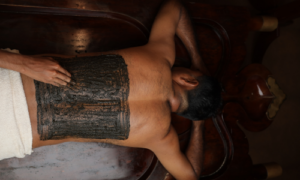
Lepam is a traditional Ayurvedic external therapy in which a warm medicated herbal paste is applied over the affected area or the entire body, depending on the condition. In the case of Sciatica, Lepam is usually applied over the lower back, buttocks, and along the sciatic nerve pathway to relieve pain and inflammation.
At Maurya Ayurveda, herbs such as Grahadoomadi Choornam or Rasnadi Choornam are used.
The paste is gently warmed and applied in a thick layer, retained for 30 minutes to 1 hour, and then removed using warm water once it dries.
Benefits of Lepam in Sciatica
- Provides instant relief from burning sensation and pain
- Reduces inflammation and swelling in the lumbosacral region
- Improves blood circulation, promoting healing of tissues and nerves
- Relaxes muscles and relieves stiffness along the sciatic pathway
4. Nadi Swedam (Local Steam):
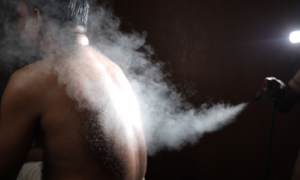
Nadi swedam is a type of localised steam(sudation therapy) in Ayurveda, using a tube or pipe(nadi) to direct medicated steam onto specific body parts. It is mostly used in the management of neurological, musculoskeletal, and circulatory disorders.
Usually, in our hospital, Dashamoola kashayam is used to produce steam. Normally steam is done for about 10-20 minutes.
Benefits of Nadi Swedam:
- It improves circulation.
- It reduces pain and numbness.
- It helps in muscle relaxation.
- It supports nerve function.
- It removes toxins.
- It reduces swelling and inflammation.
5. Abhyangam
Abhyangam is a traditional Ayurvedic full-body or localised oil massage using warm medicated oils. It is one of the most effective therapies for Vata disorders such as Sciatica, which cause pain, stiffness, and nerve irritation.
At Maurya Ayurveda, specific oils like Sahacharadi Tailam, Murivenna, or Dhanwantharam Tailam are used based on the individual’s body type (Prakriti) and severity of symptoms.
Procedure:
-
The patient is positioned comfortably on a therapy table.
-
Warm medicated oil is applied over the entire body or specifically on the lower back and legs.
-
The therapist performs synchronised massage strokes in a rhythmic manner for 30–45 minutes.
-
The session is usually followed by Swedanam (herbal steam therapy) to enhance absorption and relaxation.
Benefits of Abhyangam in Sciatica:
- Relieves pain, numbness, and muscle spasm.
- Nourishes and strengthens the nerves and muscles.
- Improves blood circulation to the lower back and legs.
- Pacifies Vata dosha, the root cause of Sciatica.
- Enhances flexibility and mobility of the spine.
- Promotes mental calmness and relaxation.
6. Elakizhi (Patra Pinda Swedam)
Elakizhi, also known as Patra Pinda Swedam, is a rejuvenating Ayurvedic therapy involving sudation (sweating) using heated bundles of medicinal leaves. These herbal poultices, called Kizhis, are filled with freshly chopped leaves, grated coconut, lemon, garlic, and rock salt, sautéed in medicated oils such as Kottamchukkadi Tailam, Dhanwantharam Thailam, or Murivenna.
Common Medicinal Leaves Used:
-
Eranda (Castor)
-
Arka (Calotropis)
-
Nirgundi (Vitex nigundo)
-
Tamarind leaves
-
Lemon slices
-
Garlic
-
Coconut gratings
Procedure:
-
The prepared herbal poultices are gently heated in medicated oil.
-
The warm bundles are then applied over the affected areas in circular and tapping motions.
-
The process induces sweating, allowing deep tissue penetration and detoxification.
-
The session lasts for 30–45 minutes, followed by rest and mild steam.
Benefits of Elakizhi in Sciatica:
- Improves blood and lymphatic circulation.
- Relieves radiating pain, tingling, and numbness.
- Removes Ama (toxins) and reduces inflammation.
- Strengthens muscles and nerves in the lumbar and leg regions.
- Reduces stiffness and improves joint flexibility.
- Restores mobility and promotes overall rejuvenation.
7. Kati Basti
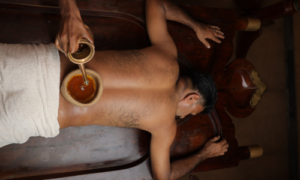
Kati Basti is one of the most effective localised Ayurvedic treatments for lower back pain and Sciatica. It involves retaining warm medicated oil over the lumbar and sacral region within a dough ring made of black gram flour.
At Maurya Ayurveda, oils such as Sahacharadi Tailam, Mahanarayana Tailam, or Kottamchukkadi Tailam are selected based on the patient’s condition.
Procedure:
-
A circular dam made of black gram dough is placed over the lower back (lumbar region).
-
Warm medicated oil is poured inside the ring and retained for 30–40 minutes, maintaining temperature throughout.
-
The oil penetrates deeply, nourishing spinal tissues and relieving nerve compression.
-
The therapy is often followed by a gentle massage or mild steam to enhance absorption.
Benefits of Kati Basti in Sciatica:
- Provides immediate pain relief and reduces inflammation.
- Releases nerve compression and relaxes paraspinal muscles.
- Improves flexibility and spinal strength.
- Nourishes the intervertebral discs and nerves.
- Helps correct Vata imbalance and prevents recurrence.
8. BASTI (Medicated Enema Therapy)
Basti, one of the most powerful Panchakarma therapies in Ayurveda, acts directly on the Pakvashaya (colon) — the primary seat of Vata dosha.
In Sciatica (Gridhrasi), where aggravated Vata causes radiating pain, stiffness, tingling, and numbness, Basti therapy works deeply to expel accumulated Vata and Ama (toxins), restore Dosha balance, and nourish the nerves and muscles.
Purpose of Basti in Sciatica:
Basti is considered the main line of treatment for Vata disorders, including Sciatica.
Therapeutic Actions:
-
Expels accumulated Vata dosha and toxins from the colon.
-
Lubricates and nourishes the spinal nerves, muscles, and joints.
-
Reduces inflammation, stiffness, and radiating pain along the sciatic nerve.
-
Improves nerve conduction and mobility, promoting faster recovery.
Methods of Basti Administration:
Two primary types of Basti are used in the management of Sciatica:
-
Sneha Basti (Oil Enema) – Nourishing and lubricating
-
Kashaya Basti (Decoction Enema / Niruha Basti) – Detoxifying and cleansing
Both forms are often used in a combined schedule known as Yoga Basti, providing a balanced approach.
8A. Sneha Basti (Oil Enema)
Purpose:
Sneha Basti pacifies aggravated Vata, lubricates the joints and nerves, relieves radiating pain and stiffness, and restores flexibility and mobility in the lower back and legs.
Procedure:
Preparation of the Patient:
-
Abhyanga (Oil Massage):
Apply Dhanwantaram Taila or Sahacharadi Taila over the body, especially on the lower back and lower limbs. It helps loosen stiffness and prepare tissues for therapy. -
Nadi Sweda (Steam Fomentation):
Performed immediately after Abhyanga to open up the channels (srotas) and enhance absorption of oil.
Preparation of Medicine:
-
Use 60–100 ml of medicated oil, warmed to a lukewarm temperature.
-
Commonly used oil: Sahacharadi Taila (specific for Sciatica, back pain, and Vata disorders).
Positioning the Patient:
-
Patient lies in left lateral position with right knee flexed toward the chest.
Administration:
-
The Basti Netra (metal nozzle) or a modern enema syringe is lubricated with oil.
-
Insert gently 2–3 inches into the rectum.
-
The warm oil is slowly injected.
-
The nozzle is withdrawn carefully, and the patient remains in position for 2–3 minutes, then lies supine.
Aftercare:
-
The patient rests for 15–30 minutes.
-
Retention time: 30–60 minutes (Sneha Basti).
-
Natural evacuation occurs without strain.
-
A light meal (rice gruel or warm soup) is advised after the procedure.
Benefits:
- Reduces radiating pain, stiffness, and numbness.
- Lubricates nerves, muscles, and joints.
- Improves mobility, bowel function, and sleep.
- Prevents recurrence of Vata aggravation.
8B. Kashaya Basti (Decoction Enema / Niruha Basti)
Kashaya Basti, a therapeutic Ayurvedic enema treatment, is primarily intended to eliminate aggravated Vata dosha and accumulated Ama (toxins) from the colon. It is classified as a cleansing or detoxifying enema (Niruha Basti), playing a vital role in the management of Vata disorders such as sciatica (Gridhrasi), low back pain, and neuromuscular conditions.
The standard Kashaya Basti formulation measures approximately 700–900 ml and consists of:
-
Kashaya (Herbal Decoction): 400 ml, prepared from Dashamoola, Rasnadi or Eranda Moola for their anti-inflammatory and Vata-pacifying properties.
-
Sneha (Medicated Oil/Ghee): 60 ml, typically Sahacharadi Taila, which nourishes and lubricates the nerves and joints.
-
Kalka (Herbal Paste): 10–20 g, made from Rasnadi Choorna and shatapushpa, acts as the main active component, enhancing Vata-pacifying, anti-inflammatory, and cleansing effects of the Basti.
-
Madhu (Honey): 50 ml, used as a natural emulsifier and detoxifying agent.
-
Saindhava (Rock Salt): 2–3 g, enhancing absorption and balancing Vata and Kapha doshas.
The mixing sequence—Madhu → Saindhava → Sneha → Kalka → Kashaya—ensures proper blending into a homogenous emulsion, making it suitable for effective therapeutic administration.
Procedure:
-
Perform Abhyanga and Swedana as preparatory steps.
-
Administer an enema with the patient in the left lateral position.
-
After administration, the patient should retain the medicine for 48 minutes (one Muhurta) and then evacuate naturally.
-
A light, warm diet (gruel, vegetable soup) is given afterwards.
Clinical Benefits of Sciatica
-
Relieves pain, stiffness, and radiating symptoms.
-
Restores motor and sensory function in the affected limb.
-
Improves muscle tone, bowel function, and sleep.
-
Prevents recurrence of Vata aggravation.
9. Raktamokshana (Bloodletting Therapy) for Sciatica
Raktamokshana, one of the Panchakarma therapies in Ayurveda, is a specialised bloodletting treatment used to remove vitiated blood and inflammatory toxins from the body.
It is particularly effective in Vata–Pitta type Sciatica, characterised by burning sensation, swelling, warmth, and acute radiating pain.
Purpose of Raktamokshana in Sciatica:
-
Removing impure blood and inflammatory mediators.
-
Reducing local congestion and nerve compression.
-
Improving circulation, oxygenation, and nutrition to the affected sciatic nerve.
-
Providing quick relief from pain, redness, and stiffness.
Methods of Raktamokshana:
The technique for treating Sciatica through bloodletting involves:
Siravedha (Venesection)
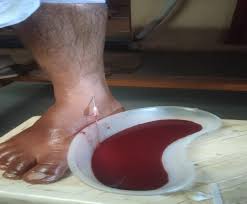
Purpose:
To drain out vitiated blood from a targeted or systemic vein to relieve inflammation and nerve pressure.
Procedure:
Patient Selection:
-
Ideal for strong individuals with good vitality.
-
Contraindicated in anaemia, weakness, or low blood pressure.
Preparation:
-
Light meal before therapy.
-
Clean and sterilise the area — usually the posterior thigh, calf, or ankle region.
Site Selection:
-
Veins along the sciatic nerve pathway, such as the Popliteal vein or Saphenous vein region, depending on pain distribution.
Technique:
-
A small incision or needle puncture is made under aseptic precautions.
-
Controlled removal of 50–100 ml of blood (based on patient condition).
-
Bleeding is stopped using Haridra (turmeric) powder or a cold compress.
Post-Procedure Care:
-
Rest for 24 hours.
-
Light, easily digestible diet.
-
Avoid physical strain and direct heat exposure.
Benefits:
-
Reduces inflammation and local congestion.
-
Relieves nerve compression and pain intensity.
-
Promotes detoxification and better blood flow.
ROLE OF PHYSIOTHERAPY IN SCIATICA
Physiotherapy for Sciatica focuses on relieving pressure on the sciatic nerve, improving spinal alignment, and strengthening supporting muscles.
A customised exercise and therapy program helps reduce pain, numbness, and tingling in the leg, promoting better mobility and posture.
Core and Strengthening Exercises for Sciatica
1. Abdominal Bracing (Core Strengthening)
Techniques:
Lie on your back with knees bent and feet flat. Tighten your core by pulling the navel toward the spine to activate abdominal muscles and support spinal stability.
Benefits:
-
Strengthens deep core muscles that support the lower back.
-
Reduces spinal stress and sciatic nerve irritation.
-
Improves posture and stability.
2. Glute Bridge
Techniques:
Lie on your back with knees bent and feet hip-width apart. Squeeze the glutes and lift the hips until shoulders, hips, and knees are in a straight line, then lower slowly to activate gluteal muscles, improve hip stability, and relieve lower back strain.
Benefits:
-
Strengthens gluteal muscles that support the spine.
-
Reduces lower back strain.
-
Improves pelvic stability and walking balance.
3. Clamshell Exercise
Techniques:
Lie on your side with knees bent and feet together. Keep the feet touching and lift the top knee without rotating the hips to activate gluteus medius, enhance hip stability, and support pelvic alignment.
Benefits:
-
Strengthens hip stabilisers (gluteus medius).
-
Helps maintain pelvic alignment.
-
Reduces lateral leg and hip tension.
Stretching and Mobility Exercises for Sciatica Pain Relief
4. Cat–Cow Stretch
Techniques:
Begin in a tabletop position on hands and knees. Inhale and arch the back for Cow Pose, then exhale and round the spine for Cat Pose to improve spinal flexibility, relieve stiffness, and enhance posture.
Benefits:
-
Increases spinal flexibility.
-
Relieves stiffness in the lower back.
-
Promotes blood flow to spinal muscles.
5. Pelvic Tilt Exercise
Techniques:
Lie on your back with knees bent and feet flat. Tighten abdominal muscles to press the lower back against the floor, then relax to strengthen core stability and reduce lower back strain.
Benefits:
-
Strengthens abdominal and spinal muscles.
-
Improves lumbar control and posture.
-
Relieves mild sciatica discomfort.
6. Piriformis Stretch
Techniques:
Lie on your back and cross one ankle over the opposite knee. Gently pull the lower leg toward the chest to stretch the piriformis muscle, relieve sciatic nerve pressure, and improve hip flexibility.
Benefits:
-
Releases tightness in the piriformis muscle (a common cause of sciatica).
-
Reduces leg and buttock pain.
-
Improves hip flexibility.
Manual Therapy Techniques
7. Soft Tissue Mobilisation
Techniques:
The physiotherapist applies slow, deep pressure to tight muscles in the back, buttocks, and thighs using myofascial release and trigger point therapy to relieve tension, reduce nerve compression, and improve mobility.
Benefits:
-
Relieves muscle tension and spasm.
-
Improves blood flow and nerve mobility.
-
Reduces pain caused by soft tissue compression.
8. Spinal Joint Mobilisation
Benefits:
-
Improves joint flexibility.
-
Decreases the mechanical pressure on the sciatic nerve.
-
Enhances posture and movement.
Mechanical Traction Method
9. Spinal Decompression Therapy
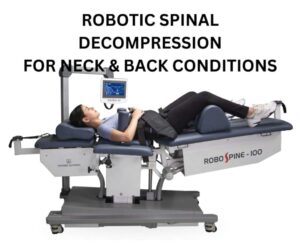
Spinal Decompression is a gentle, non-surgical therapy designed to relieve pressure on the sciatic nerve caused by herniated discs, spinal degeneration, or muscle tension. It helps restore natural disc alignment, improve circulation, and promote healing of spinal tissues.
Techniques:
The patient lies on a decompression table or traction unit. Controlled mechanical or manual traction is applied to gently stretch the spine, creating negative pressure within the discs. This allows herniated or bulging disc material to retract and reduces nerve compression.
Benefits:
-
Reduces nerve pressure and radiating leg pain.
-
Improves spinal alignment and disc hydration.
-
Enhances blood and nutrient flow to affected nerves.
-
Relieves stiffness and restores mobility.
Posture Correction and Ergonomic Training
10. Postural Re-education
Maintain a neutral spine while sitting or standing with feet flat, back supported, and shoulders relaxed. Take regular posture breaks to reduce spinal stress and prevent sciatic nerve compression.
Benefits:
-
Prevents recurrence of sciatic pain.
-
Promotes healthy spinal alignment.
-
Reduces stress on lumbar discs.
11. Safe Lifting Technique
Benefits:
-
Prevents strain on the lower back.
-
Protects spinal discs.
-
Reduces risk of injury.
Electrotherapy and Heat Modalities for Sciatica
12. TENS (Transcutaneous Electrical Nerve Stimulation)
How it’s Done:
-
Electrodes are placed over the painful area.
-
Mild electrical impulses are given for 15–20 minutes.
Benefits:
-
Provides immediate pain relief.
-
Stimulates endorphins.
-
Non-invasive and safe for home use.
13. Ultrasound Therapy
How it’s Done:
-
Conductive gel applied; ultrasound probe moved in circles for 5–8 minutes.
Benefits:
-
Promotes deep tissue healing.
-
Reduces inflammation.
-
Relieves muscle tightness.
14. Heat Therapy
How it’s Done:
-
Apply a moist heat pack on the lower back or buttocks for 15–20 minutes.
Benefits:
-
Relaxes tight muscles.
-
Increases blood circulation.
-
Reduces stiffness before exercise.
ACUPUNCTURE FOR SCIATICA
Acupuncture is a safe and effective natural treatment for sciatica pain. It works by stimulating specific energy points to reduce inflammation, relax tight muscles, and restore nerve function. This therapy improves blood flow, releases endorphins, and relieves lower back and leg pain caused by sciatic nerve compression. Regular sessions promote faster recovery, improved mobility, and lasting pain relief.
Common Acupuncture Points for Sciatica:
-
GB30 (Huantiao) – Located on the buttocks; relieves radiating pain from the hip down the leg.
-
BL54 (Zhibian) – Targets lower back and hip stiffness.
-
BL40 (Weizhong) – Found in the knee crease; helps ease leg and calf pain.
-
BL23 (Shenshu) – Strengthens kidney energy and supports spinal health.
-
GB34 (Yanglingquan) – Promotes muscle relaxation and joint flexibility.
Procedure:
-
The patient lies comfortably, usually prone or side-lying.
-
Sterile, thin needles are inserted at selected points and retained for 20–30 minutes.
-
Mild tingling or warmth may be felt, indicating energy flow activation.
Clinical Benefits:
-
Reduces acute and chronic sciatic pain.
-
Improves blood and energy flow to the lumbar and gluteal regions.
-
Restores normal gait and posture.
-
Enhances the effects of Ayurveda and Physiotherapy treatments when used in combination.
YOGA AND ASANAS FOR SCIATICA
Yoga for Sciatica focuses on improving spinal alignment, flexibility, and strength while gently decompressing the sciatic nerve. Regular practice promotes relaxation, balances Vata dosha, and prevents recurrence of symptoms.
Recommended Yoga Asanas:
1. Pawanmuktasana (Wind-Relieving Pose)
Techniques:
Lie on your back and gently hug one knee toward your chest to stretch the lower back and hamstrings. Switch sides to improve flexibility and relieve sciatic nerve tension.
Benefit: Relieves lower back pressure and reduces sciatic pain.
2. Bhujangasana (Cobra Pose)
Techniques:
Lie on your stomach with palms under the shoulders and gently lift the chest to strengthen spinal muscles, enhance flexibility, and relieve lower back stiffness.
Benefit: Opens the chest, improves circulation, and relieves lumbar stiffness.
3. Setu Bandhasana (Bridge Pose)
Techniques:
Lie on your back with knees bent and feet flat. Lift the hips upward while keeping shoulders grounded to engage gluteal and core muscles, strengthen the lower back, and improve pelvic stability.
Benefit: Strengthens the lower back, reduces pressure on sciatic nerve roots.
4. Shalabhasana (Locust Pose)
Benefit: Increases blood flow to the lumbar region, tones the glutes, and supports posture.
5. Supta Matsyendrasana (Supine Spinal Twist)
Techniques:
Lie on your back, bend one knee over the opposite leg, and twist gently to decompress the sciatic nerve, relax spinal muscles, and improve lower back mobility.
Benefit: Relieves back tension, improves spinal mobility, and reduces nerve compression.
Yoga Benefits for Sciatica:
-
Enhances spinal flexibility and alignment.
-
Reduces muscle stiffness and nerve compression.
-
Promotes relaxation and stress relief through deep breathing.
-
Improves core stability, preventing recurrence of pain.
Lifestyle Tips for Sciatica Relief
-
Maintain Proper Posture: Avoid prolonged sitting or slouching; use lumbar support.
-
Weight Management: Keeps spinal load balanced and prevents nerve irritation.
-
Regular Exercise: Engage in low-impact activities such as walking, swimming, or cycling.
-
Ergonomic Setup: Use chairs with back support and proper desk height.
-
Heat Therapy: Apply warm compresses or herbal poultices to relax tight muscles.
At Maurya Ayurveda, our integrative approach to sciatica combines Ayurveda, Physiotherapy, Acupuncture, and Yoga to provide natural pain relief, correct the root cause, prevent recurrence, and promote long-term spinal health through safe, non-invasive treatments.
DISCLAIMER: The information provided in this article is intended solely for educational purposes. Treatment decisions should be made exclusively by a well-qualified Ayurvedic physician. Self-medication is strongly discouraged.
Maurya Ayurveda Hospital, opposite to Sabine Hospital, Pezhakkapilly P.O, Muvattupuzha, Ernakulam; PIN:686673, Contact no:9947183000
Email: info@mauryaayurveda.com
Maurya Ayurveda Ortho & Neuro Rehabilitation Centre ( Ayurveda Hospital )


